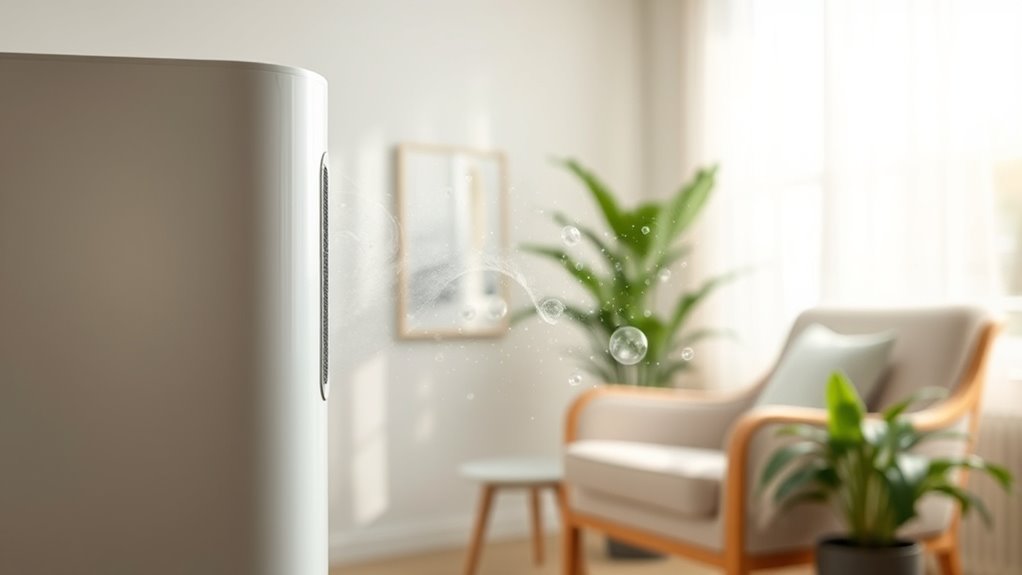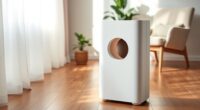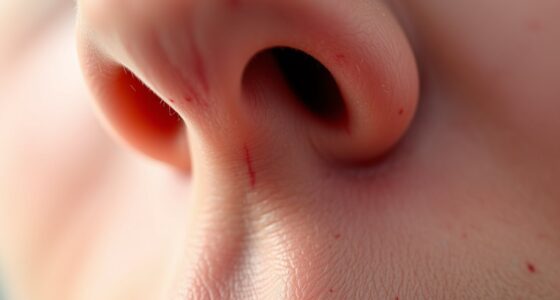CADR shows how much clean air an air purifier delivers per minute, telling you how effective it is at reducing pollutants like dust, pollen, or smoke. The higher the CADR, the faster it can cleanse the air in a room proportional to its size. Matching the right CADR to your space guarantees better air quality. To get the most out of your purifier, understanding this measurement helps you select and maintain your device effectively; there’s more to discover to optimize your air quality.
Key Takeaways
- CADR measures the amount of filtered air delivered per minute, indicating how quickly an air purifier cleans a room.
- It is calculated based on pollutant reduction rates, reflecting the purifier’s efficiency in removing specific particles like dust or smoke.
- Matching CADR to your room size ensures optimal air changes per hour, improving overall air quality effectively.
- Higher CADR values mean faster and more thorough air cleaning, especially in larger or more polluted spaces.
- Proper maintenance and placement are essential to ensure the purifier maintains its CADR performance and delivers clean air.
What Is CADR and Why Does It Matter?
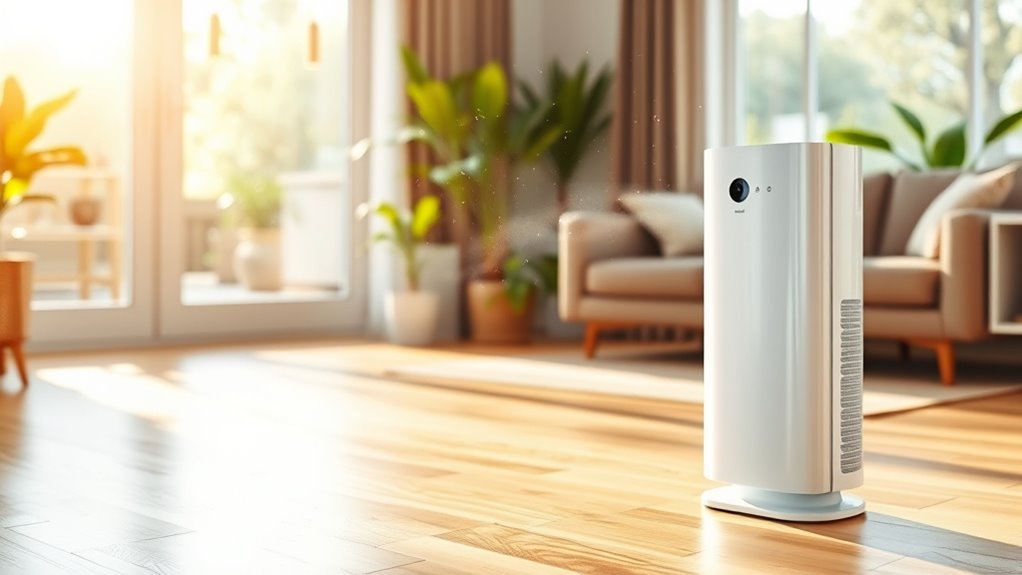
Have you ever wondered how to determine if an air purifier will effectively clean your indoor air? That’s where CADR, or Clean Air Delivery Rate, comes in. CADR measures how much filtered air an air purifier delivers per minute, directly impacting your air quality. A higher CADR means the device can remove more pollutants faster, improving your breathing environment. But it’s not just about choosing a purifier with a high number; filter maintenance is vital. Dirty or clogged filters reduce efficiency, lowering CADR and compromising air quality. Regularly replacing or cleaning filters ensures your purifier performs at its best. Knowing what CADR represents helps you pick the right unit and maintain it properly, so your indoor air stays fresh and healthy. Proper maintenance is key to sustaining optimal performance and ensuring that your air purifier continues to deliver clean air effectively.
How Is CADR Calculated?
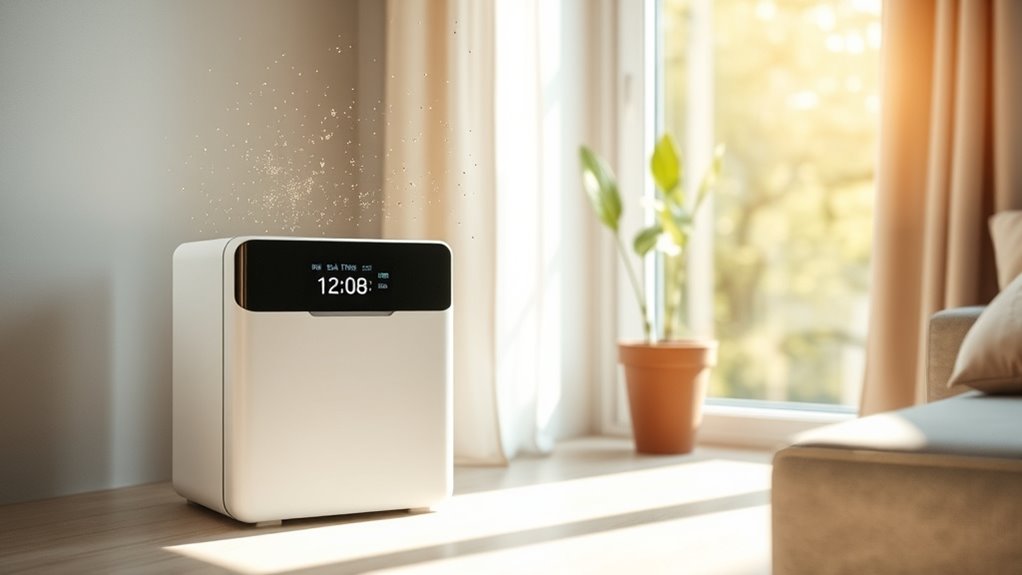
CADR is calculated by measuring the amount of clean, filtered air an air purifier produces per minute for specific pollutants like smoke, dust, or pollen. It reflects how effectively the device improves your room’s air quality. To determine CADR, manufacturers test filtration efficiency by running the purifier and measuring the reduction of particles over time. They also consider different pollutant types and their respective filtration efficiencies to provide a comprehensive assessment.
Understanding Different Pollutants and CADR Ratings
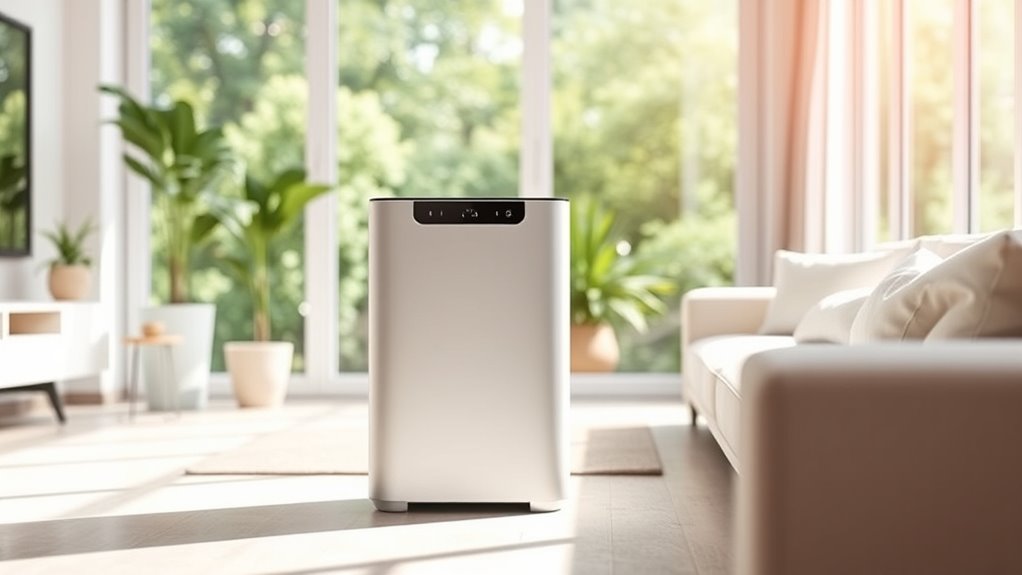
Understanding the different pollutants that air purifiers target helps you select the right device for your needs. Air quality depends on various pollutant types, such as dust, pollen, pet dander, smoke, and volatile organic compounds (VOCs). Each pollutant type affects health differently, so knowing what you need to remove is essential. CADR ratings are assigned to specific pollutants, indicating how effectively an air purifier can clean that particular type of particle. For example, a high CADR for smoke means the device excels at removing airborne smoke particles. By understanding which pollutants are most present in your environment, you can choose a purifier with appropriate CADR ratings, ensuring your indoor air quality improves effectively with targeted pollutant removal. Additionally, filter performance plays a crucial role in how well these ratings translate to real-world results.
Comparing CADR Values for Various Room Sizes
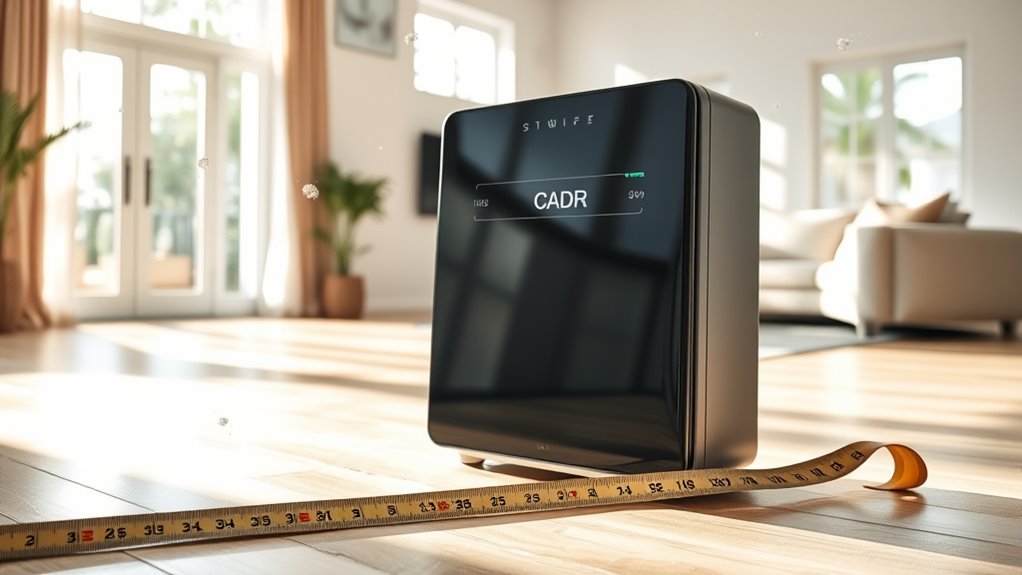
When comparing CADR values, it’s important to take into account your room size to guarantee proper air purification. Higher CADR numbers typically mean better air changes per hour, making your purifier more effective in larger spaces. Understanding these factors helps you choose a unit that offers ideal purification rates for your specific room. Additionally, selecting a purifier with appropriate air filtration technology, such as HEPA filters, ensures that allergens and pollutants are effectively removed for cleaner indoor air.
Room Size Compatibility
Choosing an air purifier with the right CADR rating depends largely on the size of the room you want to clean. To guarantee effective air purification, match the CADR to your room’s square footage. A higher CADR is necessary for larger spaces, while smaller rooms require lower ratings for optimal performance. Keep in mind that proper air purifier maintenance helps sustain its efficiency, especially in bigger rooms. Also, consider indoor humidity levels, as high humidity can impact air quality and the purifier’s ability to filter particles. If your room is too large for the purifier’s CADR, it won’t circulate clean air effectively. Ensuring the correct air purifier specifications helps you select the most suitable device for your space. Choosing the right match ensures you get the most benefit from your device without overworking it or wasting energy.
CADR and Air Changes
Comparing CADR values across different room sizes reveals how effectively an air purifier can achieve the desired air changes per hour (ACH). Higher CADR means faster air turnover, making it easier to maintain clean air. To maximize benefits, consider:
- Matching CADR to your room size for ideal ACH.
- Regular air purifier maintenance to keep airflow steady.
- Understanding that higher CADR can shorten filter lifespan if used continuously.
- Ensuring the filter is replaced when needed to sustain purification efficiency.
Effective Purification Rates
Have you ever wondered how CADR values translate into real-world purification effectiveness across different room sizes? The key is understanding that a higher CADR generally means faster air cleaning, but it’s also impacted by room volume. For smaller spaces, even a modest CADR can notably improve indoor air quality quickly. Larger rooms need higher CADR units to achieve the same effect. Remember, consistent air purifier maintenance ensures it performs at peak efficiency, maximizing its purification rate. When selecting a purifier, consider the room size and match it with the CADR to optimize indoor air quality. Comparing CADR values across various room sizes helps you choose the right device, ensuring cleaner air and healthier indoor environments. Additionally, understanding the performance metrics of air purifiers can help you make more informed decisions.
The Role of CADR in Air Purifier Effectiveness

Understanding how well an air purifier works starts with its CADR, which measures how quickly it cleans the air. When you match CADR with your room size, you can guarantee ideal indoor air quality. This connection directly impacts how effectively your purifier removes pollutants and allergens. For optimal performance, selecting a unit with a high clean air delivery rate ensures thorough purification in larger spaces.
Measuring Air Purification Rate
Measuring the air purification rate is essential for determining how effectively an air purifier can clean a space. This helps you understand its capacity for air filtration and allergen removal. To evaluate this, consider these key points:
- CADR Ratings: Look at the Clean Air Delivery Rate to see how much air the purifier filters per minute.
- Room Size Compatibility: Match the CADR with your room size for ideal air cleaning.
- Air Changes Per Hour (ACH): Check how often the device can cycle the air in your space.
- Filter Efficiency: Ensure the filter captures tiny particles like pollen, dust, and allergens effectively.
These factors help you gauge the purifier’s ability to deliver clean, allergen-free air efficiently.
CADR and Room Size
The effectiveness of an air purifier largely depends on matching its CADR rating to the size of your room. If the CADR is too low, purification efficiency drops, and air quality may suffer. For ideal performance, select a purifier with a CADR that aligns with your room’s size. Here’s a quick guide:
| Room Size | Recommended CADR | Purification Focus |
|---|---|---|
| Small (up to 200 sq ft) | 100-150 CFM | Quick air quality improvement |
| Medium (200-400 sq ft) | 150-250 CFM | Balanced purification |
| Large (over 400 sq ft) | 250+ CFM | Maintaining air quality |
Choosing appropriately rated purifiers ensures better air quality and maximizes purification efficiency in your space. Properly matching CADR to room size is essential for air purification effectiveness.
Impact on Indoor Air Quality
Have you ever wondered how your air purifier truly impacts your indoor air quality? The CADR rating plays a key role here. Higher CADR means more clean air circulates, directly improving air quality. Here’s how it influences you:
- It guarantees faster removal of pollutants like dust and smoke.
- It reflects filter efficiency in reducing airborne contaminants.
- It helps you pick an air purifier suited for your room size.
- It maintains consistent air quality by delivering a steady flow of clean air.
How to Interpret CADR Numbers When Shopping
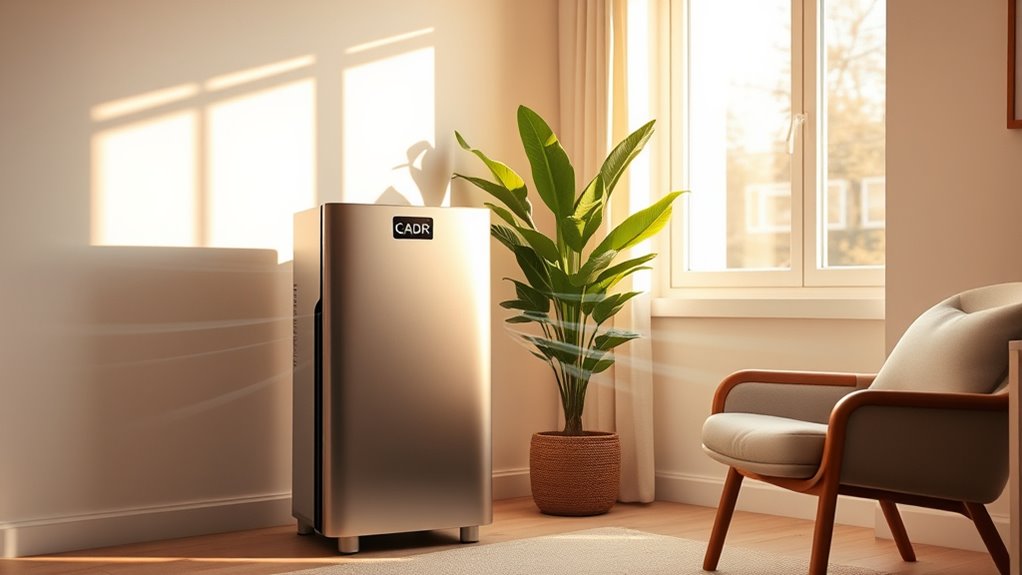
When shopping for an air purifier, understanding CADR numbers helps you choose a model that effectively cleans the air in your space. Look for CADR ratings that match the size of your room; higher numbers mean faster and more thorough cleaning. Keep in mind, a high CADR doesn’t always mean quieter operation. Check noise levels listed in the specs, especially if you’ll use the purifier in a bedroom or office. Also, consider filter maintenance needs—some models have filters that last longer or are easier to replace, which affects ongoing performance. Comparing CADR ratings alongside noise levels and filter maintenance ensures you pick an air purifier that balances cleaning power with comfort and convenience. This helps you select a device suited for your specific air quality needs. Additionally, choosing a model with auto functionality can optimize performance by adjusting operation based on real-time air quality.
The Relationship Between CADR and Air Changes Per Hour
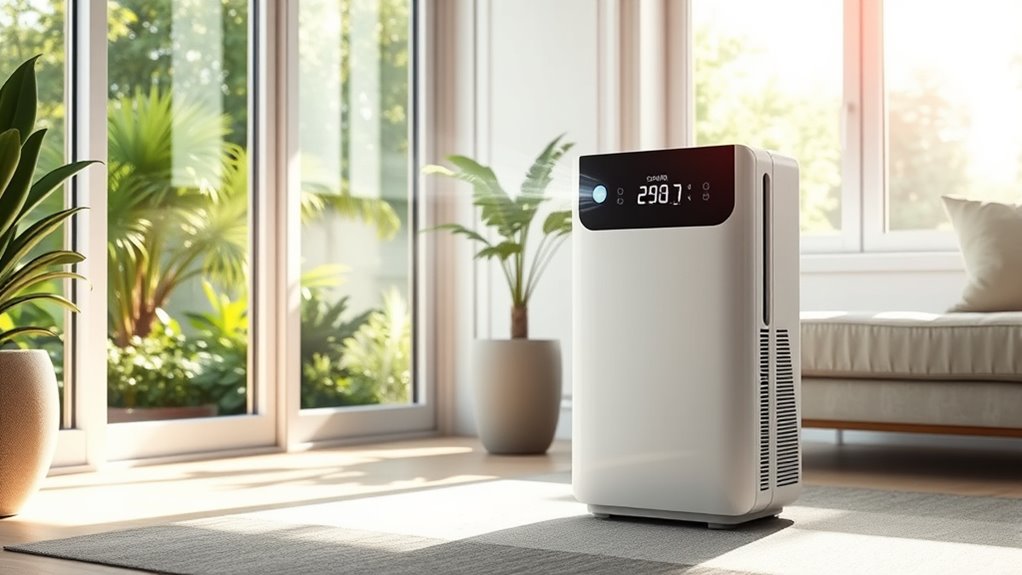
Your CADR score directly impacts how quickly your air purifier can clean a room, which relates to its airflow rate. By understanding the airflow rate, you can see how it influences the number of air changes per hour (ACH). Calculating ACH helps you determine how often the air in your space gets refreshed, ensuring better air quality. Additionally, air purifier design factors such as filter efficiency and fan performance also play a role in overall air cleaning effectiveness.
CADR and Airflow Rate
The relationship between CADR (Clean Air Delivery Rate) and airflow rate is fundamental to understanding how air purifiers improve indoor air quality. Higher airflow rates generally increase CADR, boosting pollutant removal and airflow efficiency. Here’s what you need to know:
- Increasing airflow rate can raise CADR, improving pollutant removal in your room.
- Efficient airflow ensures the purifier moves enough air to clean the space effectively.
- Too high airflow might reduce airflow efficiency if the purifier isn’t designed for it.
- The right balance between airflow rate and CADR optimizes pollutant removal without sacrificing efficiency.
- Incorporating advanced machine learning algorithms in air purifier design can help optimize airflow settings for maximum efficiency and performance.
ACH Calculation Method
Calculating Air Changes Per Hour (ACH) helps you understand how effectively your air purifier circulates and refreshes indoor air. To determine ACH, you divide your purifier’s CADR by your room’s volume and multiply by 60. This calculation shows how many times the air in your room gets filtered and renewed each hour. A higher ACH means better pollutant removal and improved air filtration, reducing airborne contaminants quickly. For instance, if your room is 300 cubic feet and your purifier’s CADR is 150 cubic feet per minute, your ACH is (150 / 300) x 60 = 30. This indicates your purifier refreshes the air 30 times per hour, optimizing pollutant removal and maintaining healthier indoor air quality. Understanding ACH helps you choose the right purifier for your space.
Real-World Examples of CADR in Action
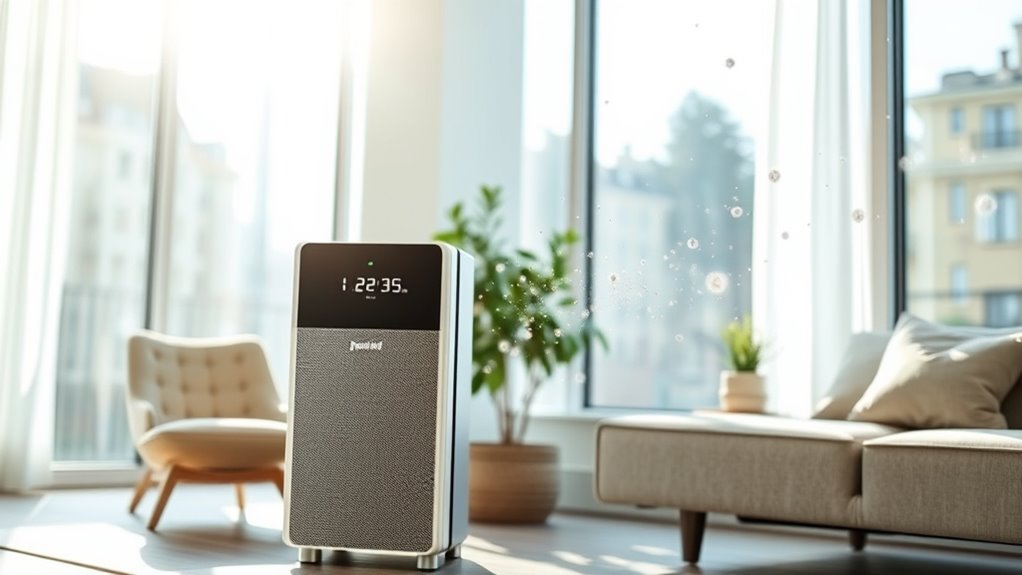
Ever wondered how CADR ratings translate into cleaner air in everyday environments? When you use an air purifier, real-world results depend on factors like room size and air quality. For example:
- In a small bedroom, a CADR of 150 can markedly reduce dust and pollen with proper air purifier maintenance.
- Larger living rooms with CADR ratings over 250 clean indoor air faster, making them ideal for busy households.
- Outdoor air quality impacts indoor environments; high CADR units help combat outdoor pollution seeping inside.
- Indoor vs outdoor air quality varies, so choosing a purifier with the right CADR ensures you get effective filtration without overworking the device.
- The effectiveness of a purifier also depends on air exchange rate and proper placement within the room, maximizing the CADR’s benefits.
Knowing these examples helps you select the right air purifier to improve your indoor air, regardless of external conditions.
Limitations of CADR as a Sole Measurement
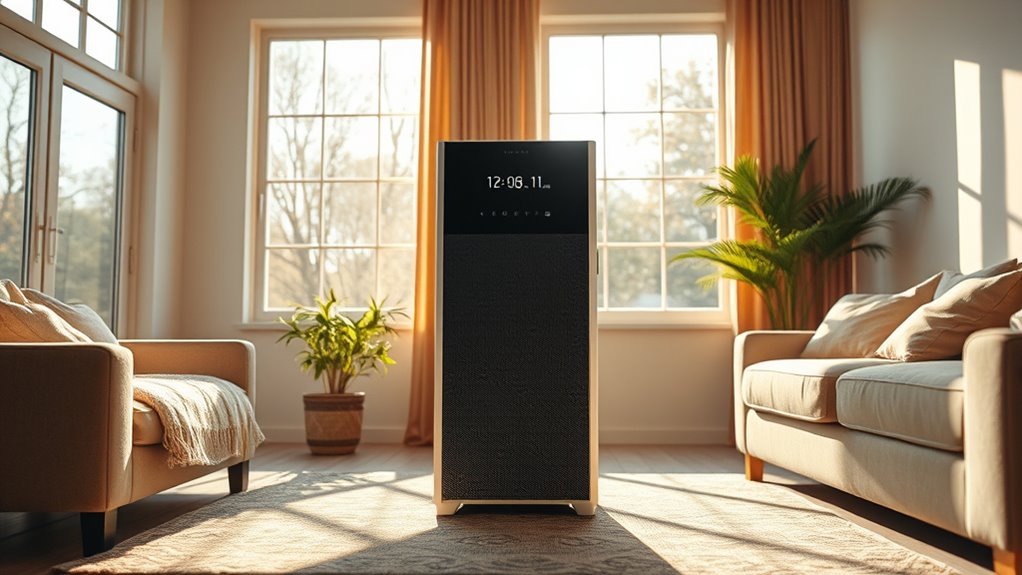
While a high CADR score indicates strong filtration performance, relying solely on this number can be misleading. It doesn’t account for how effectively your air exchange rate maintains healthy pollutant levels over time. For example, an air purifier with a high CADR in a large room might not keep pollutant levels low if it’s not operating continuously or if airflow is obstructed. Additionally, CADR measures only particulate removal and doesn’t consider other pollutants like gases or VOCs. Factors such as room layout, airflow patterns, and occupancy influence actual air quality. So, a high CADR doesn’t guarantee cleaner air if the purifier isn’t properly placed or if ventilation isn’t sufficient. Understanding the limitations of CADR can help you make more informed decisions about air purification. Always view CADR as one piece of the puzzle in managing indoor air quality.
Tips for Choosing the Right Air Purifier Based on CADR
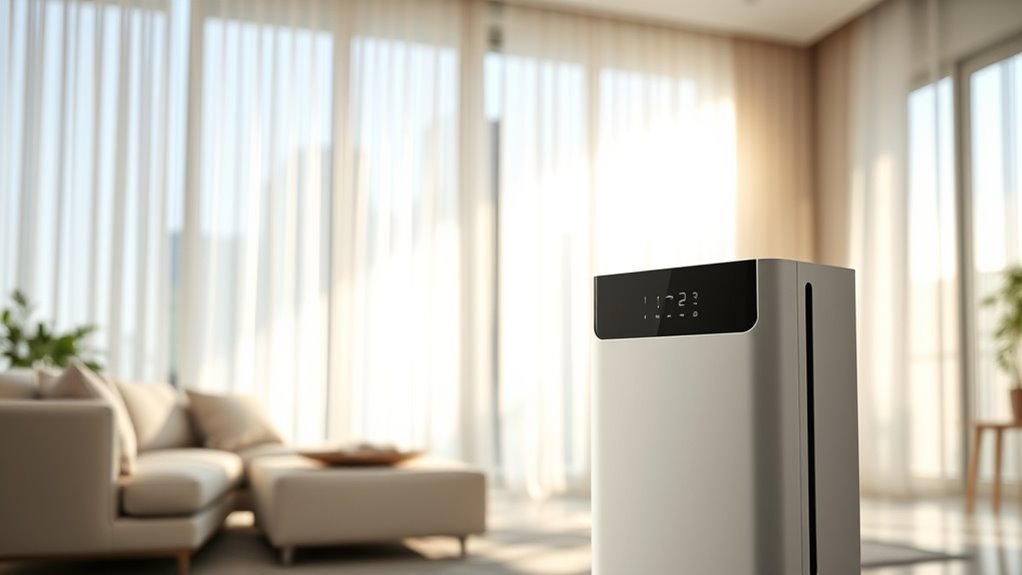
Choosing the right air purifier based on CADR involves matching the device’s filtration capacity to your room size and specific needs. To improve air quality and filter efficiency, consider these tips:
Match your air purifier’s CADR to your room size and needs for optimal air quality.
- Measure your room’s size accurately to select a purifier with a CADR rating appropriate for that space.
- Prioritize higher CADR ratings for pollutants like smoke or pollen, which need faster filtration.
- Check the filter type; HEPA filters provide better air quality by capturing small particles.
- Ensure the purifier’s features, like adjustable fan speeds, help you customize performance based on your environment.
Frequently Asked Questions
How Does CADR Compare to Other Air Quality Indicators?
CADR provides a clear measure of how much clean air a purifier delivers, but it doesn’t directly compare to other air quality metrics like PM2.5 or VOC levels. While CADR focuses on filtration efficiency and airflow, sensor accuracy in measuring pollutants can vary, affecting readings. You should consider both CADR and real-time sensor data to get an all-encompassing view of your air quality, ensuring your environment stays healthy.
Can a Higher CADR Always Ensure Better Air Purification?
A higher CADR usually means better air purifier efficiency, but it doesn’t always guarantee cleaner air. For example, a high CADR unit might produce more noise, affecting your comfort and willingness to run it continuously. Also, factors like filter quality matter. So, while a higher CADR helps, consider noise levels and overall device quality to guarantee ideal air purification without sacrificing peace and quiet.
How Often Should I Replace Filters Based on CADR Ratings?
You should replace filters based on their filter lifespan recommendations and your maintenance schedule. Higher CADR units often have filters that need more frequent replacement due to increased airflow and particle capture. Check the manufacturer’s guidelines, but generally, plan to change filters every 6 to 12 months. Regular maintenance ensures your purifier runs efficiently, maintains peak CADR, and keeps your air clean. Adjust your schedule if you notice reduced airflow or odors.
Does Room Layout Affect the Effective Use of CADR?
Sure, your room configuration and furniture placement can turn your air purifier into a decorative paperweight. If you position it behind a bulky sofa or in a cramped corner, the CADR‘s magic gets lost. Think of your space as a stage—clear the way for airflow, position the purifier centrally, and keep furniture out of the way. This way, your air gets cleaned efficiently, instead of swirling around like a bad dance move.
Are There Environmental Impacts Associated With High CADR Air Purifiers?
High CADR air purifiers can have some environmental impacts, mainly due to increased energy consumption. As you use more powerful units, they might draw more electricity, which could contribute to higher carbon emissions depending on your energy source. Additionally, manufacturing and disposing of these purifiers involve resource use. So, while they improve air quality, you should balance their benefits with their environmental footprint by choosing energy-efficient models.
Conclusion
While a high CADR promises cleaner air, it’s not the full story—you might have the best purifier, but if your room’s size or airflow isn’t right, its effectiveness drops. Don’t rely solely on numbers; consider your space and pollutants. Ultimately, understanding CADR helps you make smarter choices, balancing what’s measurable with what truly improves your air quality. Because in the end, clean air isn’t just about ratings—it’s about the environment you create.
